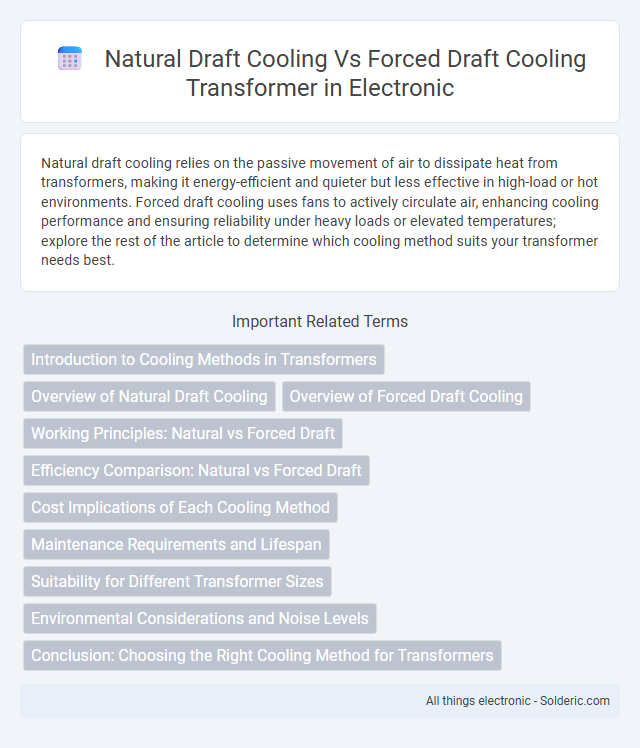Natural draft cooling relies on the passive movement of air to dissipate heat from transformers, making it energy-efficient and quieter but less effective in high-load or hot environments. Forced draft cooling uses fans to actively circulate air, enhancing cooling performance and ensuring reliability under heavy loads or elevated temperatures; explore the rest of the article to determine which cooling method suits your transformer needs best.
Comparison Table
| Feature | Natural Draft Cooling | Forced Draft Cooling |
|---|---|---|
| Cooling Method | Uses natural convection airflow | Uses fans or blowers to force airflow |
| Energy Consumption | Zero auxiliary energy | Consumes electrical energy for fans |
| Cooling Efficiency | Lower, depends on ambient conditions | Higher, consistent air circulation |
| Noise Level | Minimal, silent operation | Higher due to fan noise |
| Maintenance | Low, no moving parts | Higher, fans require maintenance |
| Initial Cost | Lower cost | Higher due to fan and control system |
| Reliability | High, simple system | Dependent on fan operation and controls |
| Application | Small to medium transformers | Medium to large transformers with high heat load |
Introduction to Cooling Methods in Transformers
Natural draft cooling in transformers relies on the natural convection of air to dissipate heat, utilizing air density differences without mechanical assistance, resulting in energy-efficient and low-maintenance operation. Forced draft cooling employs fans or blowers to actively circulate air, enhancing heat transfer rates and enabling better temperature control, crucial for high-capacity transformers under heavy load conditions. The selection between natural and forced draft cooling depends on transformer size, ambient conditions, and performance requirements, balancing cooling efficiency against operational costs.
Overview of Natural Draft Cooling
Natural draft cooling in transformers relies on buoyancy-driven airflow, where warm air naturally rises without mechanical assistance, making it energy-efficient and ideal for outdoor installations. This passive cooling method uses large cooling fins or radiators to dissipate heat, maintaining transformer temperature within safe limits. Compared to forced draft cooling, natural draft systems require minimal maintenance and provide quieter operation but may be less effective in high-load or compact environments.
Overview of Forced Draft Cooling
Forced draft cooling in transformers utilizes fans or blowers to actively circulate air across the transformer's radiators, significantly enhancing heat dissipation compared to natural draft systems. This method ensures consistent cooling performance regardless of ambient wind conditions, enabling higher load capacities and improved operational reliability. Key components include forced air movers, temperature sensors, and control systems designed to optimize airflow and maintain transformer temperature within safe limits.
Working Principles: Natural vs Forced Draft
Natural draft cooling in transformers relies on the buoyancy effect, where warm air rises naturally through cooling ducts or radiators, promoting passive heat dissipation without external power. Forced draft cooling utilizes mechanical fans or blowers to actively circulate air over the transformer surfaces, significantly increasing heat transfer rates and enabling more efficient temperature control. The natural draft system is energy-efficient but limited by ambient conditions, while forced draft ensures consistent cooling performance under varying operational loads.
Efficiency Comparison: Natural vs Forced Draft
Natural draft cooling transformers rely on ambient air movement, resulting in lower operational energy consumption but potentially less effective heat dissipation under high load conditions. Forced draft cooling transformers use fans or blowers to actively circulate air, enhancing heat transfer and maintaining optimal temperature, which can improve overall transformer efficiency during peak demand. Your choice between these cooling methods affects energy efficiency and transformer longevity, with forced draft systems typically offering superior cooling performance at the cost of additional power usage.
Cost Implications of Each Cooling Method
Natural draft cooling transformers incur lower operational costs due to passive airflow and reduced energy consumption but often require higher upfront investment in larger radiators and space for air circulation. Forced draft cooling transformers involve increased operational expenses stemming from power usage for fans and more complex maintenance demands, yet they offer compact designs and better control over temperature. Choosing between the two depends on balancing initial capital expenditure with long-term energy and maintenance costs specific to the application and installation environment.
Maintenance Requirements and Lifespan
Natural draft cooling transformers require less frequent maintenance due to the absence of mechanical components, resulting in lower operational costs and reduced downtime. Forced draft cooling transformers utilize fans that demand regular inspection, cleaning, and potential replacement, increasing maintenance intensity to ensure optimal performance. The lifespan of natural draft transformers generally exceeds that of forced draft models, as the simpler cooling method minimizes mechanical wear and the risk of fan-related failures.
Suitability for Different Transformer Sizes
Natural draft cooling suits smaller transformers by utilizing ambient air circulation for heat dissipation, offering simplicity and lower operational costs. Forced draft cooling is ideal for larger transformers, employing fans to enhance airflow and efficiently manage higher heat loads, ensuring optimal performance and reliability. Your choice depends on transformer size and cooling requirements for effective thermal management.
Environmental Considerations and Noise Levels
Natural draft cooling transformers rely on ambient airflow to dissipate heat, resulting in lower energy consumption and minimal environmental impact due to the absence of mechanical fans. Forced draft cooling transformers use fans to enhance airflow, which can increase noise levels significantly and contribute to higher operational energy costs. Your choice should balance the quieter, eco-friendly benefits of natural draft systems against the more effective heat dissipation but louder operation of forced draft cooling.
Conclusion: Choosing the Right Cooling Method for Transformers
Selecting the right cooling method for transformers depends on factors such as load capacity, environmental conditions, and maintenance requirements. Natural draft cooling offers energy efficiency and quieter operation, making it ideal for low to medium load applications, while forced draft cooling provides superior heat dissipation for high-capacity transformers in demanding environments. Understanding your transformer's operational needs ensures you optimize performance and extend equipment lifespan.
natural draft cooling vs forced draft cooling transformer Infographic

 solderic.com
solderic.com